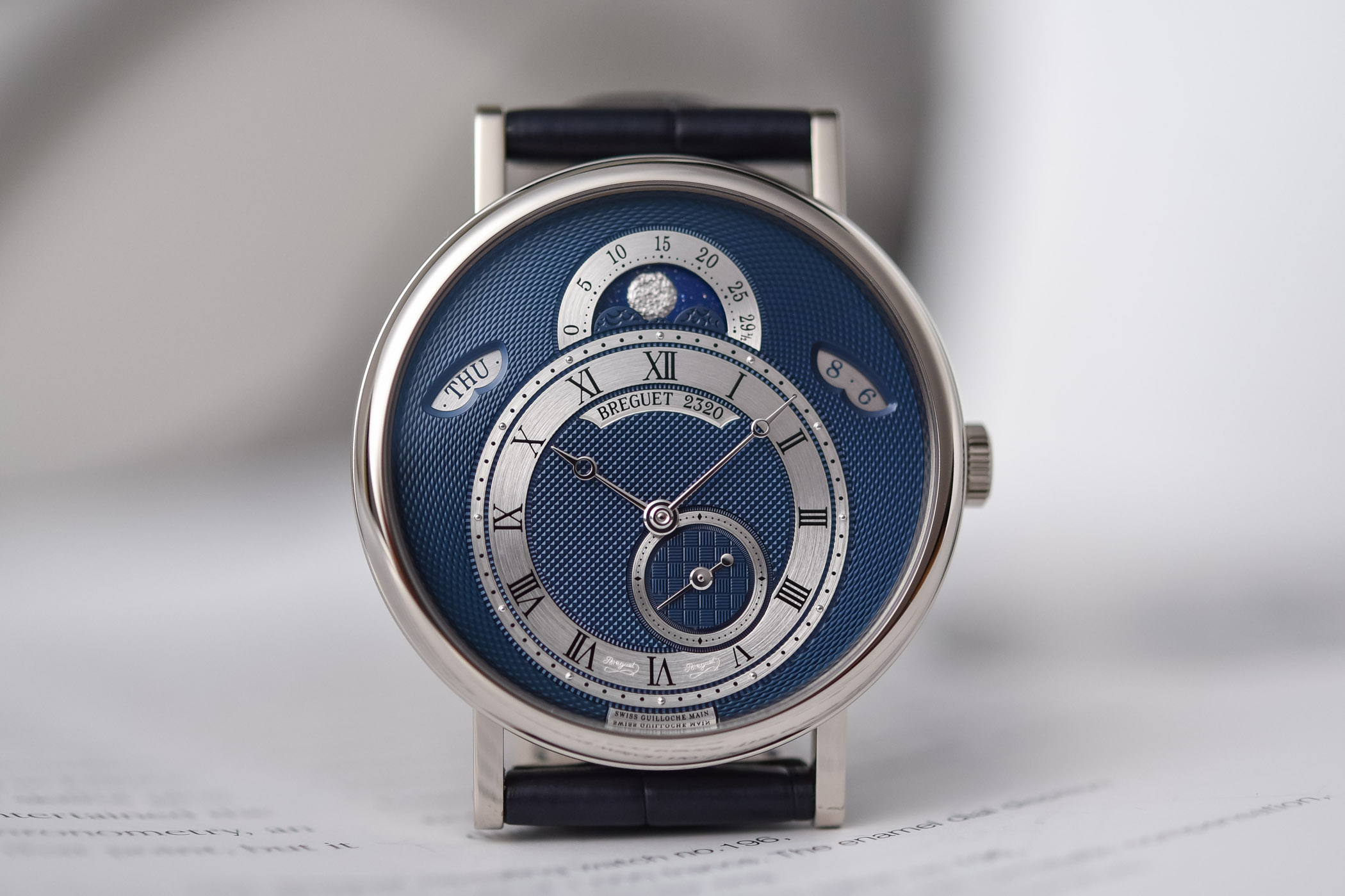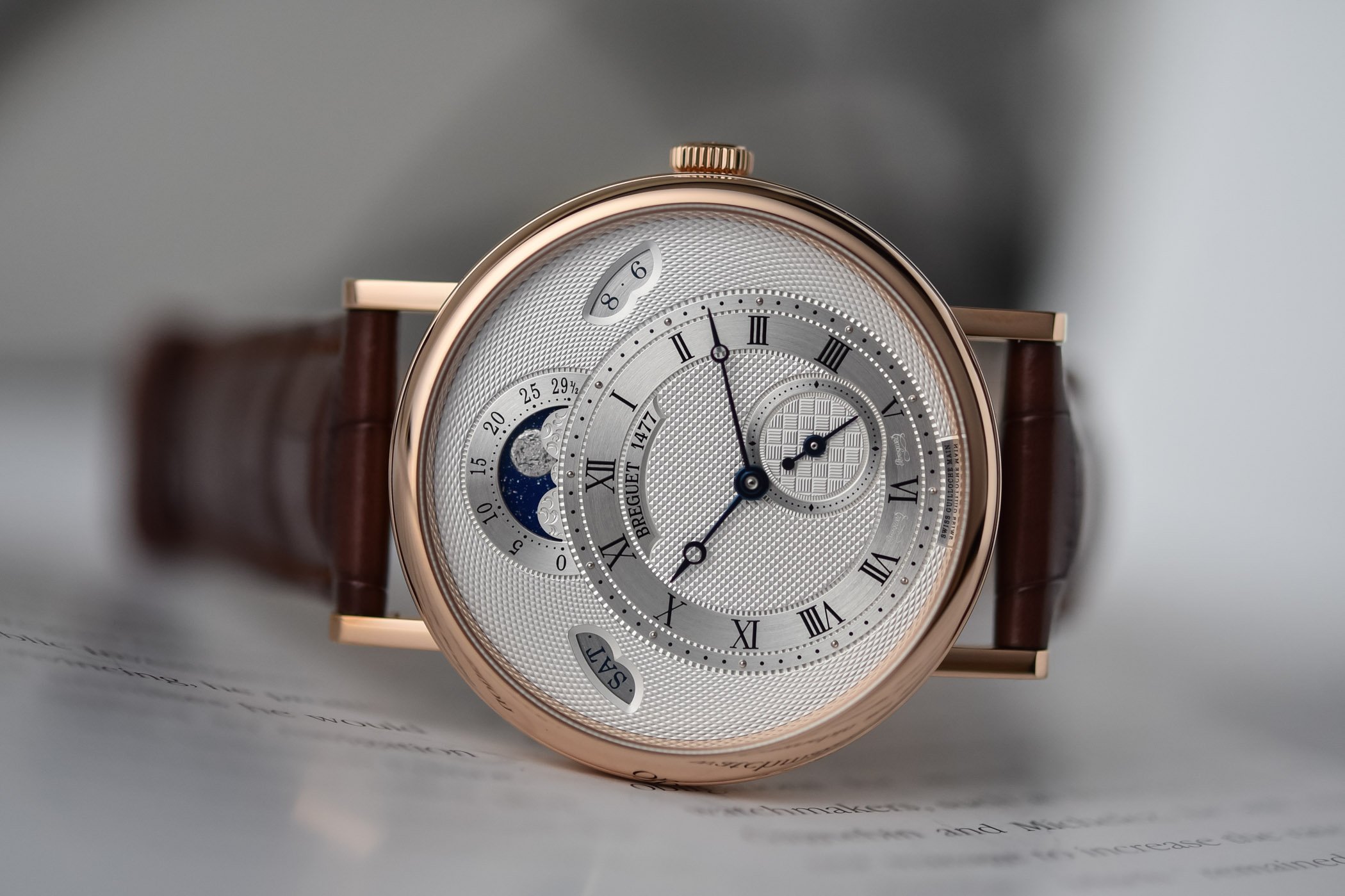The 2020 Breguet Classique 7337 Calendar & Moon With New Dials
Two hundred years old and still looking good. Meet the new versions of the 7337, one with a stunning new 'Breguet-blue' dial.

Earlier this year, Breguet unveiled its models for 2020 including this Classique 7337 Calendar & Moon watch. One of the main themes at Breguet for 2020 has been the introduction of blue dials in its Classique family with the 7137 Moon & Power Reserve, this 7337 Calendar & Moon and the 5377 Tourbillon Extra-Plat. Like so many Breguet watches, the 7337 was inspired by a historical pocket watch (well, in fact, two historical pocket watches) made by founder Abraham-Louis Breguet in the early 1800s. The exquisite layout of the original dial with its impeccable guillochage and the off-centred arrangement has been the muse for various iterations over the years. However, having had the privilege of a hands-on session with both the rose gold/silver dial and white gold/blue dial models of 2020, the only problem we had was deciding which one was our favourite.
Historical References
During his lifetime (1747-1823), Breguet’s innovative and highly technical mind led to the invention of the spring-gong for repeater watches, the first shock-absorber device (para-chute), the Breguet balance spring, the sympathique watch, the tact watch, and of course the tourbillon, patented on 26 June 1801. But Breguet was also famous for his aesthetic approach to watchmaking creating a new design language that eschewed the overly decorated watches of the day. Rebranded in more contemporary marketing jargon as the ‘unmistakable signs’ of a Breguet watch, features like guillochage, off-centred displays, enamel dials, caseband fluting, Breguet hands and numerals, and a host of other Breguet decorative dictates are rigorously upheld today.

One of the historical inspirations that is not specifically mentioned by the brand, but that we believe inspired the 7337, was the Breguet tact watch no. 4579. A delightful gold pocket watch, no. 4579 was sold to Monsieur De Roos on 1 June 1829 for the sum of 5,080 francs. (A quick search throws up the name of John Frederick Fitzgerald de Roos, a British Royal Navy commander. Was he the mystery man who bought this watch?) Displaying a moon phase indicator at noon, two lateral apertures for the day of the week and the date, a large off-centred hour ring for the hours and minutes, and even a small power reserve indicator, no. 4579 also featured Breguet’s ingeniously simple way of telling the time by touch. Using a pointer on the outside case to reproduce the position of the hour hand, the wearer could then calculate the time by counting the studs on the sides of the case. Sold from 1799 on, tact watches were sometimes known as ‘watches for the blind’ but you can imagine the utility of this system in a long-winded meeting or in a dark cabin below deck. It is a feature of elegant women and men, in order to tell the time without having to pull your watch out of its pocket.
The other pocket watch – no. 3833, sold in 1823 – is officially cited as the inspiration behind the reference 7337. It certainly displays the same layout and practically the same functionality as the current reference, but it was a half-quarter repeating watch. Whichever way, and taking into account that the power reserve indicator on the historic models was abandoned in exchange of a small seconds counter, there can be no doubt that these historic pocket watches were behind Breguet’s ref. 7337.

Following the acquisition of the brand by Swatch Group in 1999, a wristwatch closely modelled on the above-mentioned pocket watches (and earlier models made when Breguet was owned by Investcorp) appeared in Breguet’s collection. Known as Ref. 7337, it was released in yellow, white and rose gold with silver dials. The two new 2020 models join this illustrious family displaying the subtle but effective design modifications on the dial and the novelty of a ‘Breguet blue’ dial colour. The case, the case size and even the movement are all identical to the existing models.

eccentric harmony
If you were to take all the features of the dial and lay them out on a table and then ask somebody from outside the watch industry to arrange them harmoniously, chances are you’d get a pretty ugly dial. Therein lies Abraham-Louis Breguet’s extraordinary talent for arranging disparate elements on a dial to create a harmonious effect. Instead of settling for a more conventional arrangement of peripheral hours and minutes and the phases of the moon at 6 o’clock, Breguet went for an extremely unorthodox layout.
Here, for example, you have a plump, bottom-heavy figure-eight composed of the hours and minutes chapter ring surmounted by a smaller arch-shaped moon phase indicator, exactly the same as the arrangement found on the historic pocket watches. On either side of the hour ring are two bosom-shaped apertures inclined at an angle, one at 10 o’clock for the day of the week and the other at 2 ‘clock for the date. And then there is the running seconds disc inserted inside the hour ring at an odd 5 o’clock position. What is remarkable is just how harmonious and appealing this unconventional layout results.
The most apparent modification has taken place in the moon phase aperture at noon. The older 7337 models have a classic golden ‘Man in the Moon’ face surrounded by golden stars. The new silver embossed moon in the aperture is far more realistic. Complete with craters, the silver moon floats in a midnight blue sky punctuated with different sizes of silver stars. Another subtle modification is the use of slightly thinner, less heavy numerals on the hour ring (Roman) and the age of the moon (Arabic). The hands are classic Breguet open-tipped hands, which Breguet designed in 1783.
Guillochage
Breguet was the first watchmaker to apply guillochage to his dials and used different styles of guillochage to delineate the different functions and enhance legibility. Even without modern-day inventions like luminescent paint, you have to admit that the dials of both the 7337 watches are remarkably clear and easy to read; perhaps even more so in the blue version, which benefits from a greater contrast between the blue guilloche background and the silvered tracks.
The technique of guillochage has barely changed since Breguet’s days and guillocheurs in Breguet’s manufacture still rely on historic rose engine lathes operated by hand. You can get a feel for what this entails in our article and this short video filmed at Breguet. Starting life as a solid 18k gold blank, an engraver chisels the areas on the dial that will feature guillochage. Here you can see the central part of the dial has been decorated with a hobnail pattern (clous de Paris) while the small seconds at 5 o’clock has a chequerboard (damier) motif and the rest of the dial is engine-turned with a barleycorn pattern (grain d’orge). In addition to delineating the different functions, the guillochage provides a matte glare-free background that enhances legibility no end. Some light hand-engravings are also found next to the moon indication, which has also been updated with a realistic moon surface instead of a ‘face’ in previous editions.
The case is faithful to Breguet’s philosophy of neo-classical elegance and simplicity. Measuring 39mm across and with a height of 9.9mm, the case – in white gold or rose gold – is the essence of sobriety with a minimum of decoration, save for the hallmark fluting on the caseband.
Calibre 502
Underneath the sapphire crystal caseback is Breguet’s classic calibre 502 – in this case, the 502.3 QSE1. An ultra-thin automatic movement, the calibre has a thickness of just 3.80mm. Echoing the eccentric layout of the dial and the guillochage decoration, the rotor is also offset and decorated with guillochage. The bridges are bevelled and decorated with Geneva stripes and you can just discern the profile of the open barrel spring. Comprised of 236 components, with 35 jewels and running at a 3Hz frequency, the power reserve is 45 hours. It also features modern components like the incorporation of a silicon balance spring and a lever escapement with silicon horns.
Thoughts
Owning a Breguet Classique 7337 Calendar & Moon is like wearing a slice of history on your wrist. Practically every design detail harks back to the founder’s aesthetic dictates. What is surprising though is the timelessness of Breguet’s unusual layouts, as intriguing today as they were two hundred years ago.
While the silver dial model is classic Breguet to the core, the ‘Breguet blue’ model is even more intriguing. I know that Brice prefers the silver dial (editor’s note: I indeed prefer the silver version… but I have zero objectivity regarding this watch, being my all-time favourite Breguet watch), a colour that you won’t grow tired of in the long run, but my heart goes out for the blue dial. The crisp contrasts and the elegant shade of blue make it hyper-easy to consult and give it a more contemporary mood.
Price & Availability
Depending on the model selected, the Breguet Classique 7337 Calendar & Moon is accompanied on a blue or brown alligator strap with a folding buckle matching the case material and shaped like the brand’s logo. The price for these two new versions (7337BB/Y5/9VU, white gold and 7337BR/15/9VU, rose gold) will be EUR 41,900. Both models are now available from boutiques and selected retailers.
More details at breguet.com.


















2 responses
Love this. Great design, looks incredible in blue.
Interesting article. I can forgive Breguet for his fussiness as he was an extraordinarily gifted man with great ideas for the functionality of his watches. I like a blue dial myself but would agree that the silver looks much less garish than the blue in this case (still not great though). I saw the word Breguet six times on this piece, it remind me of clothes that have the makers name all over them instead of on the label inside. Once really is enough from any angle..